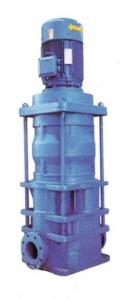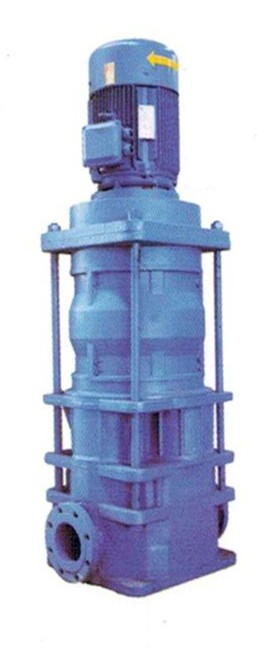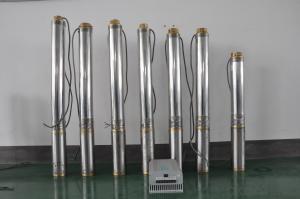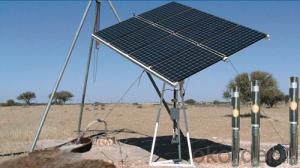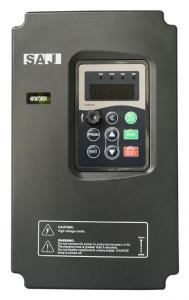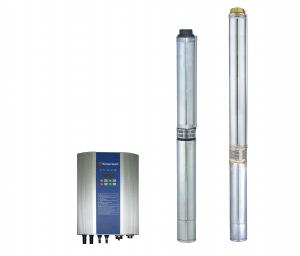Solar Water Pump L3D-24-300
- Loading Port:
- China Main Port
- Payment Terms:
- TT OR LC
- Min Order Qty:
- -
- Supply Capability:
- 300 sets set/month
OKorder Service Pledge
OKorder Financial Service
You Might Also Like
Product description:
Product: Solar water pump
Model:L3D-24-300
Appilication:
surface pump
for surface water of pond, river, lake
for irrigation of a big farm with 15000 m2 on the top of a high mountain
Product specification:
flow rate:24m3/ hour, 300m3/day.
lift: 10m-300m
pump diameter: 610mm
Pump installed on the ground, outlet to the water surface:4m
with AC motor, motor power:22kW
but only need solar power:24kW(while Grundfos pump needs at least 45kW solar power, our pump can save more than 50% solar panel power,save USD15000 cost for solar panel per set.
Material:
Pump inside: stainless steel and wearable nylon,it enables our solar pump to have 10 years sevice life.
Motor : AC motor, 380V , three phase , 50Hz. The pump also can connect with grid power directly.
Certification:
3 International patent
ISO9001
CE
Warranty:2 years
- Q:Can a solar pump be used in areas with limited access to technical support?
- Yes, a solar pump can be used in areas with limited access to technical support. Solar pumps are designed to be simple and self-sufficient, requiring minimal maintenance and technical expertise. They operate using solar energy, which eliminates the need for electricity or fuel, making them a reliable and cost-effective solution for remote and off-grid locations. Additionally, solar pumps are built with durable materials and are designed to withstand harsh environmental conditions.
- Q:How reliable are solar pumps?
- Solar pumps have proven to be highly reliable in various applications. The reliability of solar pumps depends on several factors such as the quality of the equipment, proper installation, and regular maintenance. High-quality solar pumps manufactured by reputable companies are designed to be durable and withstand harsh weather conditions. They are often made from corrosion-resistant materials and are built to last for many years. Additionally, these pumps are equipped with advanced technologies such as MPPT (Maximum Power Point Tracking) controllers, which maximize the efficiency and performance of the system. Proper installation is crucial for the reliability of solar pumps. It is important to ensure that the pump is correctly sized and installed in an optimal location with adequate sunlight exposure. Additionally, proper wiring and connections are essential to prevent any electrical issues that may affect the pump's performance. Regular maintenance is also necessary to ensure the long-term reliability of solar pumps. This includes cleaning the solar panels to maximize their efficiency, checking the pump's performance, and inspecting the system for any potential issues. By conducting regular maintenance, any problems can be identified and addressed promptly, minimizing downtime and maximizing the reliability of the pump. Overall, solar pumps have proven to be a reliable and sustainable solution for various water pumping needs. When installed and maintained properly, they can provide a consistent and efficient water supply, even in remote locations where access to grid electricity is limited.
- Q:How long does it take for a solar pump to pay for itself in terms of energy savings?
- The payback period for a solar pump varies depending on factors such as the initial cost, energy savings, and local conditions. Generally, it takes around 2 to 5 years for a solar pump to pay for itself through energy savings.
- Q:Can a solar pump be used for fish ponds or aquaculture?
- Yes, a solar pump can be used for fish ponds or aquaculture. Solar pumps are an eco-friendly and cost-effective option for circulating and aerating the water in fish ponds. They can help maintain water quality by adding oxygen to the pond, which is essential for the health and well-being of the aquatic life. Solar pumps can also be used to create water currents, which can prevent the build-up of algae and other unwanted substances in the pond. Furthermore, solar pumps are typically low-maintenance and can operate in remote areas where access to electricity is limited. Overall, solar pumps are a sustainable and efficient solution for maintaining a healthy environment in fish ponds or aquaculture systems.
- Q:Can a solar pump be used for fountain or waterfall features?
- Yes, a solar pump can be used for fountain or waterfall features. Solar pumps are designed to be powered by solar energy, which means they do not require any electricity from the grid. This makes them an ideal choice for outdoor water features such as fountains or waterfalls, where running electricity can be difficult or expensive. Solar pumps are typically easy to install and operate, and they can provide a constant flow of water to create beautiful and soothing water displays. Additionally, using a solar pump for a fountain or waterfall is environmentally friendly since it utilizes renewable energy and reduces reliance on traditional electricity sources.
- Q:How does the size of the solar pump controller affect its performance?
- The size of the solar pump controller does not directly affect its performance. The performance of the solar pump controller depends on its technical specifications, efficiency, and compatibility with the solar pump system. However, it is important to ensure that the controller is appropriately sized to match the power requirements and capacity of the solar pump system for optimal performance.
- Q:Is it possible to store excess solar energy generated by the pump?
- Yes, it is possible to store excess solar energy generated by the pump. This can be done using various energy storage technologies such as batteries, pumped hydro storage, or thermal energy storage systems. Storing excess solar energy allows for its utilization during times of low solar generation or high energy demand, providing a more reliable and efficient energy supply.
- Q:How does the cost of operating a solar pump compare to a traditional pump?
- The cost of operating a solar pump is generally lower compared to a traditional pump. Solar pumps are powered by renewable energy from the sun, which means they do not require the use of electricity or fuel, resulting in reduced operational costs. Traditional pumps, on the other hand, rely on electricity or fuel, which can be expensive and subject to price fluctuations. Solar pumps have lower maintenance costs as well since they have fewer moving parts and do not require frequent repairs or replacements. In contrast, traditional pumps may require regular maintenance, such as oil changes, belt replacements, or motor repairs, which can add to the overall operating expenses. Additionally, solar pumps are environmentally friendly as they do not emit greenhouse gases or contribute to air pollution, unlike traditional pumps that often rely on fossil fuels. This not only reduces the carbon footprint but also eliminates the need for storing, transporting, and handling potentially harmful substances. While the upfront cost of purchasing and installing a solar pump may be higher than that of a traditional pump, the long-term savings in operating costs, maintenance, and environmental impact make solar pumps a more cost-effective and sustainable option.
- Q:Can solar pumps be used in remote locations?
- Yes, solar pumps can be used in remote locations. They are an ideal solution for areas that lack access to grid electricity as they operate solely on solar power. This makes them a reliable and cost-effective option for remote areas where traditional electricity infrastructure is limited or not available at all.
- Q:Can a solar pump be used in areas with harsh weather conditions?
- Yes, a solar pump can be used in areas with harsh weather conditions. Solar pumps are designed to be durable and withstand extreme weather conditions such as high temperatures, heavy rains, and strong winds. They are built with weather-resistant materials and often have protective features like waterproofing and dustproofing. Additionally, solar pumps are designed to work efficiently even in low light conditions, allowing them to continue functioning in cloudy or overcast weather.
1. Manufacturer Overview |
|
|---|---|
| Location | |
| Year Established | |
| Annual Output Value | |
| Main Markets | |
| Company Certifications | |
2. Manufacturer Certificates |
|
|---|---|
| a) Certification Name | |
| Range | |
| Reference | |
| Validity Period | |
3. Manufacturer Capability |
|
|---|---|
| a)Trade Capacity | |
| Nearest Port | |
| Export Percentage | |
| No.of Employees in Trade Department | |
| Language Spoken: | |
| b)Factory Information | |
| Factory Size: | |
| No. of Production Lines | |
| Contract Manufacturing | |
| Product Price Range | |
Send your message to us
Solar Water Pump L3D-24-300
- Loading Port:
- China Main Port
- Payment Terms:
- TT OR LC
- Min Order Qty:
- -
- Supply Capability:
- 300 sets set/month
OKorder Service Pledge
OKorder Financial Service
Similar products
New products
Hot products
Hot Searches
Related keywords
